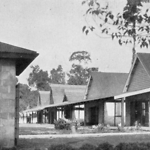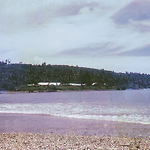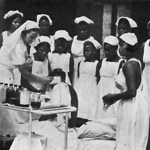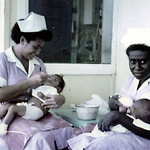Concept: Medical Services
- Alternative Names
- Hospitals
Details
In the early years of the Protectorate, social services were slight and non-existent in some areas. Touring officials with little training attended as best they could to some minor ailments and village sanitation. The first medical doctor in the Solomon Islands was Henry Palmer Welchman (q.v.), an Anglican missionary who served the Diocese of Melanesia between 1888 and 1908. The Diocese established St. Luke's boys' school at Siota at the western end of Nggela's central channel in 1896, at the same time as Resident Commissioner C. M. Woodford (q.v.) first staffed the Protectorate. For some time the church considered opening a hospital there, which would have obviated the need for a large hospital on Tulagi, but this came to nothing. Dr Welchman served half-years at St. Luke's School from 1896 until 1900, and then on the island of Isabel until 1901. The Diocese decided to open the first well-established hospital in the Protectorate at Hautabu, near Maravovo on Guadalcanal, and in 1911 the first doctor arrived, Dr Russell Marshall. The hospital opened in 1912 and by 1915 had one hundred patients. They paid for their treatment with local foods and by working after discharge in the hospital gardens. The hospital was closed in 1915 when the doctor married the matron and went off to the First World War, never to return. (Boutilier 1974, 22-23) Two other early medical missionaries were Dr John Northcote Deck, a nephew of Florence Young (q.v.), the founder of the South Sea Evangelical Mission (q.v.). Deck joined the Mission in 1909 as its resident head, and his brother Norman, a dentist, joined in 1913.
After he visited Tulagi in 1911, High Commissioner Sir Henry May reported that the settlement was in need of a small hospital to deal with routine medical care and 'a limited number of lunatics'. (Boutilier 1974, 10-11) In 1912, the Protectorate began the first government hospital at Tulagi in a leaf hut. A proper government hospital first opened there in 1915 with two doctors, one of whom worked on circuit throughout the islands. There were two buildings ninety metres southeast of the Tulagi wharf. In one was an eighteen-bed ward for male Solomon Islanders, an isolation ward, a women's ward, and a four-bed ward for the 'better class' of Asians and Solomon Islanders. The other building contained the Medical Officer's office, an operating theatre, a dispensary, small wards to cater for European men and women, and nurses' quarters. There was no x-ray equipment or any laboratory, the lighting plant worked erratically, and the quarters were cramped. Staffing was a constant problem and nurses were in very short supply, the joke in the Protectorate being that they were soon snapped up in marriage by eligible European bachelors. The first nurse, Edith E. Elliot, and Dr Nathaniel Crichlow (q.v.), the first Government Medical Officer, arrived in Tulagi in 1914.
The medical staff changed regularly because of health issues, marriages or an inability to cope with the extremes of life in the Protectorate. On occasions there was no doctor at all, as in 1920 when Dr Crichlow was granted four and a half months of leave after five and a half years of continuous service. Full staffing was only achieved in about 1924, and even then if one doctor was away on leave only one government doctor remained in the Protectorate. (Boutilier 1974, 11-15) Starting in 1922, Tulagi's hospital was also used to train orderlies from each of the districts. Six years later there were twelve Islanders on duty at the hospital, four posted to other government stations, and four based at Gizo district hospital. Twenty dressers were scattered in villages all over the Protectorate. (Boutilier 1974, 26)
After having their own resident doctor, Welchman, for many years, in 1915 and 1920 European residents on Isabel petitioned the Protectorate for a permanent medical magistrate. Gizo residents similarly petitioned and were granted a medical officer from 1919, but without provision for a hospital. Then, in 1926, Gizo residents petitioned for a resident nurse. (Boutilier 1974, 18) The Methodist Mission (q.v.), which had operated in Roviana Lagoon (q.v.) since 1902, opened a fully equipped hospital at Kokeqolo in 1927 under the charge of Dr Edward Sayers. Earlier, some of the missionaries who where qualified nursing sisters had attended to minor injuries and illnesses, and the Methodists had run a yaws injection campaign, largely eradicating the disease from the mission's immediate area. The mission hospital was forty kilometres away down a smooth lagoon, which was enough for Resident Commissioner Kane (q.v.) to cancel the appointment of a nurse at Gizo. In 1928, the Methodists established a second hospital at Sasamungga on the Bambatana coast of Choiseul. It was made from local materials and was staffed by Dr C. S. James, a member of the Royal College of Surgeons, and a European nurse, plus local staff. Almost no previous medical work had been done on Choiseul. The two hospitals cost the Methodists £17,302 between 1928 and 1933, defrayed by a £400 government subsidy. (Boutilier 1974, 20) The Seventh-day Adventists opened their first hospital at Marovo Lagoon (q.v.), run by a trained nurse. Their first hospital with a medical practitioner was opened on Kolombangara Island in 1937, also in the Western Solomons.
During the 1910s and 1920s, Malaita was better served by qualified medical personnel than any other island outside of Tulagi. SSEM missionary Norman Deck, a dentist, worked on Malaita from 1913, his brother John Northcote Deck, a medical practitioner, resided on Malaita or at Aola, Guadalcanal onwards from 1909. Most of the Deck brothers' services went to maintaining SSEM adherents and staff. (BSIP 14/59, District Officer W. R. Bell to Resident Commissioner R. R. Kane, 9 July 1926; BSIP 14/24a, Government Secretary to Bell, 5 July 1926)
Even so, the vast majority of Malaitans then received no medical care from either government or the missions. The Protectorate Government recognized that Malaita had the largest population and needed more medical care, and after the massacre of William Bell (q.v.) and his party in 1927 there was recognition that the government needed to provide health and education care in return for taxation. Direct Head Tax was netting the Protectorate £10,000 a year from Malaita, far more than the estimated forty-five thousand inhabitants ever got in return. However, aside from the Decks, most of the medical care was provided by a mission and a company. The Anglicans re-entered the medical field in 1927 by opening the Hospital of the Epiphany at Fauabu, west Malaita, but the plans were too grand and money incompetently spent. They had a good medical practitioner in Cambridge-educated Dr L. M. Maybury, who had to design and build the hospital himself. It opened on 16 June 1929 with forty beds in several concrete-floor buildings and an operating theatre. There were two trained nurses from New Zealand and six local dressers. In 1933 the number of beds was increased to eighty, and Maybury also began a leprosarium which consisted of a small concrete ward surrounded by local style houses for the patients, of which seventy-nine were under treatment in 1930. Despite a government subsidy of £5 to a total cost of around £17 per patient, this facility closed in 1933 due to insufficient funds, only to open again on a smaller scale in 1938. Maybury also encouraged a 'mothercraft school' which began at Siota in 1938, teaching Western nursing techniques to women who then returned to their villages. More formal nursing training did not begin until 1941. There were constant issues about infringing of Malaitan ancestral rules, but Dr S. M. Lambert, part of a yaws and hookworm eradication team which visited Fauabu in 1933, described the hospital as 'very well run'. (Hilliard 1978a, 267-269; Boutilier 1974, 22, 31; Lambert 1933)
Aside from the medical facilities at Fauabu, the other hospital on the island was run by Dr Lily Holt-MacCrimmon, the wife of Neil MacCrimmon, Manager of Mala Timber Company, who both lived at Su'u from 1919. After many years of tending to the sick in her area, in 1926 the government recognised Dr Holt-MacCrimmon's work and provided her with a small two-ward hospital with a dispensary, at an annual cost of £500. It had accommodation for twelve patients, and during 1927 there were 104 in-patients as well as six hundred outpatients. The government also provided the surgical equipment and the drugs. Within a few years Su'u had become an important medical centre for the Malaita District, until the couple shifted to Vanikolo Island in 1932. (Boutilier 1974, 26, 27)
The late 1920s were crucial for the next phase: Islanders were being trained at Tulagi to serve as what would later be called 'dressers'-medical orderlies. Solomon Islanders began to be trained for these roles in the 1920s, and Native Medical Practitioners (q.v.) were trained in Fiji onwards from the late 1920s. (Bennett 1987, 210) And Solomon Islanders began to be trained as Native Medical Practitioners in Fiji. The first was George Bogesi, who was based at Auki, Malaita from 1931.
The task of the government doctors was to inspect all labourers and visit some plantations and to be available for the white and Chinese communities. Dr Crichlow, who was part Chinese, worked as Medical Officer at Tulagi and both Medical Officer and District Officer on Makira between 1919 and 1927, after which he became the Protectorate's travelling Medical Officer. In the 1930s, there were two government doctors, and other doctors worked for the SSEM, the Methodists and the Melanesian Mission, and for private companies such as the Vanikoro Kauri Timber Company (q.v.).
Government subsidies were paid to the Melanesian Mission and Methodist hospitals, and to the Vanikoro Kauri Timber Company. The latter provided a doctor for its staff, who also served many of the people of the Santa Cruz Islands. The Protectorate also had a travelling medical ship, the Hygenia, in effect a floating hospital. This spurt of interest in providing medical services was extended when the American Rockefeller Foundation mounted a large yaws and hookworm eradication campaign between 1928 and 1932 (q.v. Health). The speed with which the inflamed red ulcers disappeared after one shot from the 'nila' (the needle) greatly boosted Solomon Islanders' belief in the efficacy of Western medicine.
During the Second World War, both the Japanese and the Americans developed extensive medical facilities for their own troops, and to a limited extent Solomon Islands also benefitted from these. Guadalcanal, as the major American base, had the largest medical facilities, which was one reason Honiara was chosen as the site of the new capital in 1944; when Honiara was established in 1945 its hospital was opened in the remains of a wartime hospital. The operating theatre had wire-netting walls (spectators had to be removed during operations), the roof leaked and there was no plumbing. The building of the Central Government Hospital at Mataniko, Honiara-commonly known as 'Numba 9' (the 9th American building)-began in 1955. The first wards to open were for Out-Patients, Dental Surgery, and Tuberculosis, along with a Dispensary. This later became the National Referral Hospital. (PIM Sept. 1952, Nov. 1955; NS 1 July 1955, 12 July 1955)
The medical services were completely disorganised during the war, but a reorganisation was partly effected by 1948. Various extension schemes were made possible by grants under the Colonial Development and Welfare Fund. At the end of 1950, the Protectorate Medical Department consisted of a Senior Medical Officer, four Medical Officers, eleven Assistant Medical Practitioners, four nursing sisters and seventy-one district dressers. The Central Protectorate Hospital was equipped with 120 beds and able to provide surgical, x-ray and laboratory services. However, the wartime buildings were dilapidated and had outlived their usefulness. In March 1950, a new European ward was established, with accommodation for six patients and plans were underway to begin reconstructing the entire hospital the next year. In 1950, the Central Hospital received 1,376 in-patients, 8,259 outpatients and conducted 2,871 laboratory examinations and 750 x-ray examinations. The rebuilding of Central Hospital was nearing completion in 1954. (AR 1953-1954, 31) It was further rebuilt between 1954 and 1958, and was supplemented by three district hospitals: Auki Hospital on Malaita was built over 1953-1954, while essential repairs were made to Gizo Hospital and Kirakira Hospital was expanded. Some Native Councils employed dressers and provided funds for buildings and equipment for dispensaries. (AR 1953-1954, 28) The missions also maintained hospitals at Fauabu, Malaita (Diocese of Melanesia), at Kukudu, Western Province (Seventh-day Adventist), and at Bilua, Western District (Methodist Mission).
In 1948 construction had begun for a leprosarium at Tetere, thirty-two kilometres from Honiara on Guadalcanal, using the Colonial Development and Welfare Fund and funds from the New Zealand Leper Trust Board. Building materials were scarce and by 1950 the settlement was only partly completed, and capable of accommodating twenty-four patients. Specially trained sisters from the Catholic Mission carried out nursing duties. Other hospitals for leprosy patients were operated by the Diocese of Melanesia, the Seventh-day Adventist Mission and the Methodist Mission, which were supplied free sulphone drugs by the government. (AR 1949-1950, 25-26) An eighteen-month training course for dressers was introduced at Central Hospital in February 1950: twenty-six trainee dressers began the course, nine were eliminated by examinations at the end of the year, and successful candidates were posted to work in villages.
In 1960, in addition to the Central Hospital, there were government hospitals in each of the other three district headquarters: Gizo (Western), Auki (Malaita), and Kirakira (Eastern), and two rural hospitals, at Malu'u and Tataba. There were also sixty-two rural health centres and twenty-two rural maternity and child welfare centres. Dressers or medical assistants were in charge of the former and locally registered nurses or midwives were in charge of the latter. There was also the government leprosarium at Tetere and the small mission leprosaria in Western and Malaita districts. Two mission hospitals with overseas doctors in charge were situated at Fauabu on Malaita (Diocese of Melanesia) and at Munda on New Georgia (Methodist Mission). Most of the many mission stations throughout the Protectorate also provided medical care that varied from basic first-aid to simple hospitals run by overseas nursing sisters. (AR 1959-1960, 41) At Nafinua, the SSEM maintained a training school for midwives. (AR 1963-1964, 51) A new hospital was opened at Buala, Isabel Island, in June 1966 and work had started on a hundred-bed hospital at Auki. (NS June 1966, 27 July 1966) The site for a Honiara mental hospital was surveyed in 1954, and construction was completed in 1956. (AR 1955-1956, 6)
In 1962, the government medical staff consisted of a Director, five Medical Officers, sixteen Assistant Medical Officers (four on secondment from Fiji), ninety dressers and medical assistants and twenty-eight trainee medical assistants. Nursing staff included a Matron, a sister-tutor, five sisters, eighteen nurses and nineteen trainee nurses. Local Councils employed twenty-two nurses to staff maternal and child health clinics. The principal hospitals remain unchanged: Central Hospital, Honiara, and District Hospitals at Auki, Gizo and Kirakira along with rural hospitals at Malu'u and Tataba. Medical Officers were available at Gizo and Auki, and Senior Assistant Medical Officers ran the other hospitals. There were also sixty-two rural health clinics and twenty maternal and child health clinics staffed by dressers or medical assistants or nurses. Two church hospitals had overseas doctors in charge in 1961-1962, at Fauabu run by the Anglicans on Malaita, and at the Methodist hospital at Munda. (AR 1961-1962, 49, 50)
By 1967, the principal government medical institutions were still Central Hospital, Honiara (148 beds), and the district hospitals at Kilu'ufi near Auki (one hundred beds), Kirakira (fifty-six beds), and Gizo (forty-six beds). Rural hospitals operated at Malu'u (thirty-six beds plus a hostel for transient patients) and Buala on Isabel (thirty-six beds). Kilu'ufi Hospital was opened by the High Commissioner in October 1967. The government leprosarium at Tetere was still staffed by three nursing sisters from the Catholic Marist Order, joined in 1967 by a fourth sister qualified as a physiotherapist. The New Zealand Leper Trust Board helped establish a Physiotherapy Department at Tetere. (AR 1967, 55)
In 1970, Central Hospital was expanded with a twelve-bed ward for the handicapped, mainly those suffering aftereffects of poliomyelitis. In 1974, a hostel opened at the hospital, run by the Society for the Crippled People and funded by the Ryder Cheshire Foundation and local donations, which could accommodate ten male and eight female patients undergoing rehabilitation. The School of Nursing was also run from Central Hospital. (AR 1974, 80) Other hospitals were also expanded: Malu'u had a twenty-bed tuberculosis annex, and a new thirty-two bed hospital was completed and opened at Graciosa Bay on Santa Cruz. The church medical services slowly expanded as well, and many church-run centres provided medical service ranging from simple dressings or first-aid treatments to in-patient hospital care by nursing sisters. (AR 1970, 61) As independence approached, in 1974 government hospitals had just under five hundred beds, supplemented by 275 in mission-run hospitals, totalling 771 beds for a population estimated at 178,940. See also Nurses' Training School.
Related entries
Published resources
Books
- Bennett, Judith A., Wealth of the Solomons: A History of a Pacific Archipelago, 1800-1978, University of Hawai'i Press, Honolulu, 1987. Details
- Hilliard, David, God's Gentleman: A History of the Melanesian Mission, 1849-1942, University of Queensland Press, St Lucia, 1978a. Details
Journals
- Pacific Islands Monthly. Details
- British Solomon Islands Protectorate (ed.), British Solomon Islands Protectorate News Sheet (NS), 1955-1975. Details
Manuscripts
- Boutilier, James A., The Role of the Administration and the Missions in the Provision of Medical and Educational Services in the British Solomon Islands Protectorate, 1893-1942, Anglican Church of Canada, Church House Library, Toronto, 1974, 75 pp. Details
- Lambert, S.M., May-June 1933 Diary of Sylvester M. Lambert, University of California San Diego, Special Collections, MSS 682, box 3, folder 22, 1933. Details
Reports
- British Solomon Islands Protectorate, British Solomon Islands Protectorate Annual Reports (AR), 1896-1973. Details
Images
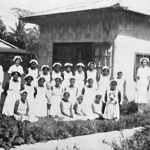
- Title
- Hospital of the Epiphany, Fauabu, Malaita, doctor, staff and probationer nurses
- Type
- Image
- Date
- 1950s
- Source
- DOM
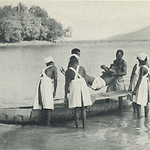
- Title
- Hospital of the Epiphany, Fauabu, Malaita, patient brought ashore from a canoe
- Type
- Image
- Date
- 1950s
- Source
- DOM
